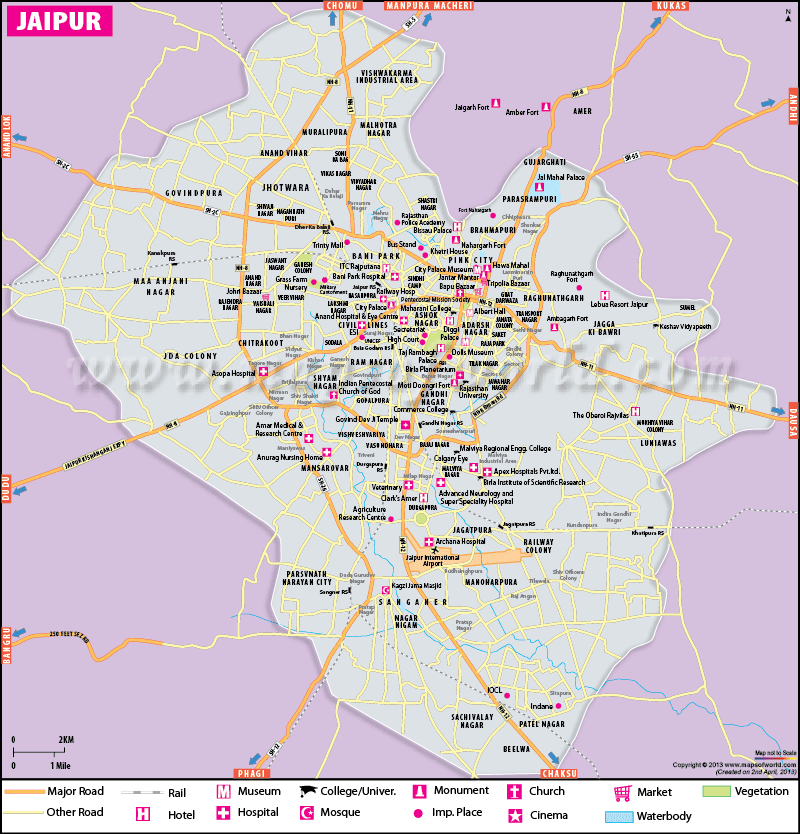About City
Popularly noted as the Pink City, Jaipur was founded by Sawai Jaisingh II in 1727 A.D. The capital city of Rajasthan carves a niche for its glorious past and varied culture. Even today, you can get a glimpse of its history through its magnificent palaces and forts. Though the architectural planning of the city is ancient, the execution is certainly modern. This is well reflected in the City Palace architecture. The city holds an approximate population of 7.4 million.
Geography
Located in the eastern part of Rajasthan, the Aravali hill engulfs Jaipur from three sides. The cities of Ajmer and Nagaur lie to the city’s west, Sikar and Alwar are on its north, Bharatpur and Dausa zones lie in the east while Sawai Madhopur and Tonk lie in the south. With an average altitude of 1414 feet, the city lies in an extremely dry as well as sandy area.
How to reach (transport)
The city makes a mark for its transportation mode. Those traveling by air can count on the Sanganer Airport which operates regular flights to/from Udaipur, Jodhpur, Ahmedabad, Mumbai, Kolkata, Delhi as well as other prominent destinations. Besides, international tourists can also avail of connecting flights from Muscat and Dubai to reach Jaipur. Besides, the city is connected to all major destinations of the country through railways. Trains operate from Agra, Delhi, Bangalore, Ahmedabad, Udaipur, Jodhpur, Bikaner, Kolkata, Chennai, and Mumbai and you can avail of the same to reach Jaipur. Another convenient mode of transportation is the by-road option. The city offers regular AC and deluxe bus services to the neighboring cities. (verify this Sanganer Airport? it is Jaipur airport)
When to visit
Jaipur has a hot semi-arid climate and its temperature remains relatively high throughout the year. The best time to visit Jaipur is from October to March. Winters last from December to February and are believed to be a good time for sightseeing and holidaying. Tourists don’t really prefer the summers that last from April to May. Monsoons start from June and last up to September. This period is mostly favored by nature enthusiasts and rain lovers.
Culture (fairs and festivals) and traditions
Recognized as a culturally vibrant city, Jaipur’s culture is a perfect blend of modern and conventional traditions. Even if it has been transformed into a metropolitan hub, it still retains its royalty through its striking customs and traditions. Even the local fairs and festivals reflect the vibrant culture of Pink city. Some of the well-known fairs and festivals celebrated here are:
- Elephant Festival is celebrated in the month of February or March at Jaipur Polo grounds. The elephant festival is usually celebrated on the day of Holi, wherein beautifully decorated elephants entertain the spectators. The elephants are assembled at the stadium for polo matches or royal processions. To add galore to the festival, there are also arrangements for dance performances and Rajasthan folk music.
- Similar to the Elephant Festival, Gangaur is also celebrated in the Month of March or April. The festival is celebrated in honor of Goddess Gauri, an incarnation of Goddess Parvati. In Jaipur, the day begins with a colorful procession. The procession lasts for two days and starts from Zanana Deodhi and ends at Talkatora. In between, it passes through Tripolia Bazar, Gangauri Bazar, and Chaugan.
- Teej celebrated in the month of July or August is an important festival of Jaipur. The festival marks the advent of monsoon. On this day, swings are decorated with flowers and are hung from trees. Dedicated to Goddess Parvati, the day starts with young girls singing songs of love. Similar to Gangaur, here too a procession is organized for two days.
- Donkey Fair or Khalkani Mata Mela is celebrated in October. On this day, hundreds of donkeys from North India are brought for selling and buying. Donkey races are also organized for the entertainment of the people.
Points of interest (places to visit)
Some of the major points of interest in Jaipur are:
-
- Hawa Mahal, a grandstand of the Pink City is built of pink and red sandstone. The palace houses five stories and was constructed by Maharaja Sawai Pratap Singh in the 18th century.
Jantar Mantar is noted for its astronomical instrument collections. The collections include geometric devices to measure time, track stars in their orbits, predict eclipses, and much more.
- The City Palace is an important point of interest in Jaipur. The construction work for the same was initiated in 1732, but then modifications continued to the late 19th century. The last structure that was added to the city palace complex in the Mubarak Mahal. The City Palace also serves as a host to religious festivals, royal weddings, and coronations.
- Jal Mahal is situated in the midst of the Man Sagar Lake and carves a niche for its remarkable architecture and palatial comfort.
- Built using white marble, the Laxminarayan Temple is also known as the Birla Mandir. The temple is located below the Moti Dungri Fort and is dedicated to Goddess Lakshmi and Lord Vishnu.
Accommodation
Jaipur offers the perfect blend of luxury and budget accommodation options. Those interested in lavish accommodation can plan their stay at The Oberoi Rajvilas, Royal Heritage Haveli, and Taj Rambagh Palace while those on a tight budget can look for cheaper options like Royal Orchid Central, Hotel Sarang Palace, and Hotel Shalimar.

